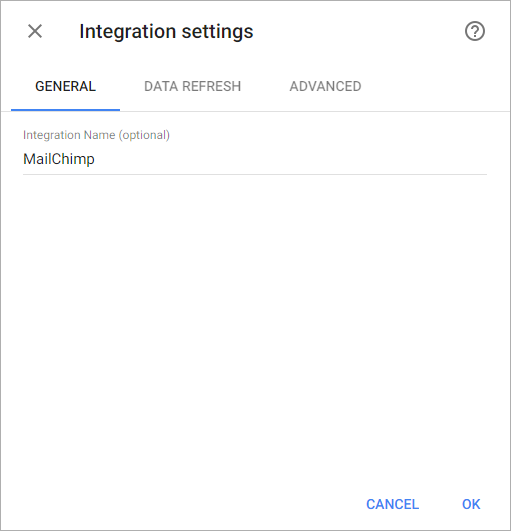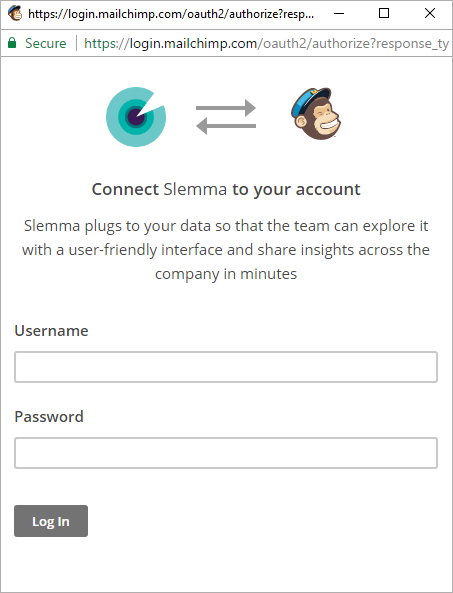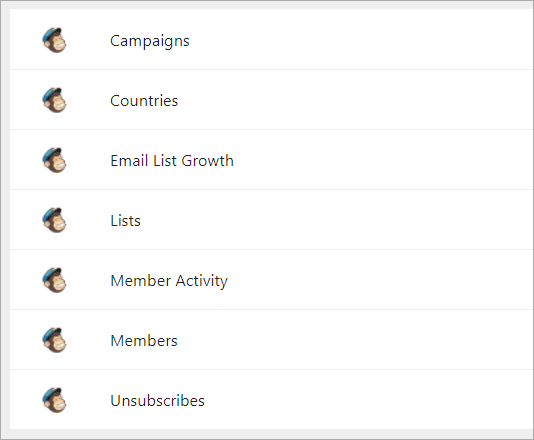MailChimp is an email service provider (ESP), which helps marketers send bulk emails to clients, customers, and other interested parties.
From this article you can learn:
- How to connect my MailChimp account with Slemma
- How to get data from MailChimp
- How to create a chart on my MailChimp integration
Creating an Integration
From your Slemma account, head over to the Library page and click the plus button at the bottom right. Select Integration from the submenu.
In the following page, you can find MailChimp with one of the following ways:
- Scroll down and select MailChimp from the list of Integrations.
- Use search to find MailChimp from the list of Integrations.
- Choose MailChimp using All dropdown list > Marketing.
You’ll see the Integration settings dialog window. You can select the frequency for the automatic updates on the DATA REFRESH tab, or set weeks settings on the ADVANCED tab. Click OK.

You’ll be directed to a page to sign in. Login to your MailChimp account.

After authorization, the integration will be created and it will appear in your account in the list of objects. Now you are able to share the integration with either individuals or the entire Team, rename or remove the integration. To view the options available for the integration, right click it in the list.
Creating a Dataset
A dataset is a collection of data in a tabular format that is created on one of the possible data sources. The datasets can be used to create dashboards or individual charts.
To create a dataset, click your MailChimp integration in the list and select Browse datasets. From the following page, select which data you want to add to use in your charts.

NOTE: Cloud Service Integrations have prebuilt datasets that are not editable.
Click dataset’s name for a description of each dataset.
This data source contains statistics about your campaigns such as the average number of unique opens by send time. Dimensions Measures Templates This data source contains statistics about your campaign performance in different countries. Dimensions Measures Templates This data source contains a summary of the month-by-month growth activity for a specific list. Dimensions Measures Templates This data source contains statistics about your lists, also known as your audiencies, such as open rate, click rate and others. Dimensions Measures This data source contains information about your member activity such as members count by action. Dimensions Measures This data source contains information about all of your members such as number of members by lists and interests. Dimensions Measures This data source contains information about list members who unsubscribed from a specific campaign. Dimensions Measures Templates
Creating charts
Click a dataset or integration and select Create dashboard/Create saved chart/Create presentation to start building a chart (please note that presentations are available starting from the Standard Plan).
From the next page, you can choose to create your own chart from scratch, or you can apply one of the templates we created.
- If you choose to build a new chart from scratch (“Blank” option), the Chart designer will open. Go here to learn how to create a chart in the Chart designer.
- If you choose a template, a new chart will be added to a dashboard/saved chart/presentation (depending on the way you start the chart creation).

